- Home
- Technical Cooperation Projects
- Index of Countries
- Africa
- Tanzania
- Technical Cooperation Project in Strengthening Participatory Planning and Community Development Cycle for Good Local Governance (O&OD Project) Phase 2
- Project News
- Vol.6: Community Planning Process was conducted in Kilimanjaro Region.
Project News
2015-08-28
Vol.6: Community Planning Process was conducted in Kilimanjaro Region.
Six pilot villages in Hai, Siha and Same Districts, the Project's new target districts in Kilimanjaro Region, conducted Community Planning Process through facilitation by Ward Facilitators from August 24 to 28, 2015.
1. Background
Hai, Siha and Same Districts conducted Introductory Facilitator Training[1] for their selected local government officers from March to June this year, and embarked on introducing the "Improved O&OD" under the cooperation of the project. After the training, the trained ward extension officers started their role as Ward Facilitators (WFs) by conducting "Baseline Survey" together with the community leaders of the target village. The results of the survey were presented at the village assembly. WFs also conducted Community Leaders Training. They aimed at building awareness of the villagers in the target villages through these activities.
From August 18 to 20, 2015, the project conducted the second series training for the WFs and District Task Force members, specifically focusing on the Community Planning Process. The following week, these trained officers of the 3 target Districts conducted Community Planning Process at their target villages for 5 days, using the know-how they gained from the training.
Based on the "Guide for Supporting Community Planning Process for Facilitators" that the project developed in the previous phase, WFs facilitated the community leaders to develop Community Development Plan for five days. This process is intended to strengthen the coordination mechanism within the village for problem-finding and solution-finding.
2. 5-Day Community Planning Process
Day 1
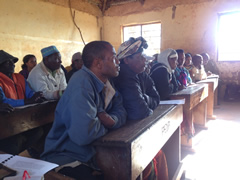 Participants listening to the explanation of Local Government Authority (LGA) officers(Lugulu Village, Lugulu Ward, Same District).
Participants listening to the explanation of Local Government Authority (LGA) officers(Lugulu Village, Lugulu Ward, Same District).
On the first day, the WFs explained the purpose and importance of Community Planning Process to the community leaders, who are the main actors of Community Planning Process.
In Lugulu Village, where the majority of villagers are Seventh-day Adventists, the week of Community Planning Process was also their week of worship. On the first day of the planning, the community leaders and the LGA officers discussed this matter and decided to shift the starting time of the planning session from 9 AM to 7 AM. For 5 days, the participants gathered at 7 AM every morning, conducted planning session for about 2 hours, and after that they went to the church to pray from 10 AM until evening. The LGA officers were initially worried if villagers could go through such a hard schedule, but the concentration and activeness of participants of Lugulu Village was exceptional, and their worries were proved wrong at the end of it all.
Day 2
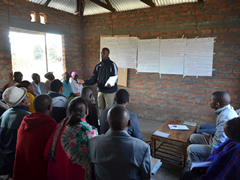 (DSC_1638)*Photo from "Mieruka site"
(DSC_1638)*Photo from "Mieruka site"
A District Task Force member giving orientations to the villagers(Wiri Village, Gararagua Ward, Siha District).
The orientation for the community leaders continued till the second day.
After the explanation on 6 steps and actual procedures of Community Planning Process, the District officers explained how the Districts will support the villages after the Community Development Plan is submitted from the villages to the District Council.
Day 3
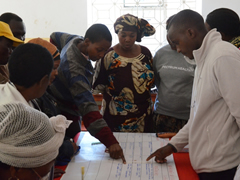 Under the facilitation by the WFs, the community leaders updating information on village council and various organizations in the village using a matrix (Fuka Village, Kilwa Ward, Siha District).
Under the facilitation by the WFs, the community leaders updating information on village council and various organizations in the village using a matrix (Fuka Village, Kilwa Ward, Siha District).
On this day, the participants reviewed the results of the Baseline Survey together, and established a common understanding on their village's actual situation. For example, they discussed the problems and needs identified through the Baseline Survey, and whether the strategies that the village employed to cope with them were effective or not. By updating the information on the achievements and current status of various social groups/organizations in the village, the community leaders assessed their own experience and capacities in problem-solving as a village.
Day 4
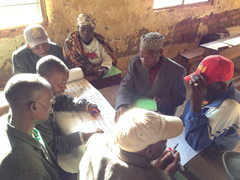 Group Discussion(Lugulu Village, Lugulu Ward, Same District)
Group Discussion(Lugulu Village, Lugulu Ward, Same District)
On the fourth day, the community leaders analyzed various issues concerning their village's development, mainly through group discussions. The participants were divided into 3 groups, each in charge of different sector: ‘Production,' ‘Social Service' and ‘Governance.' For each sector, they raised the factors that improve a development issue (Opportunities) and the hindering factors to achieve a development issue (Obstacles.)
In Lugulu Village, the group in charge of ‘Production' sector raised vulnerability of irrigation facilities as their development issue. As to ‘Opportunity', they raised existence of river, land, and potential labor force and so on. As to ‘Obstacles,' they pointed out that no villager has technical knowledge.
Day 5
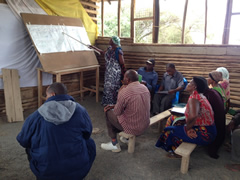 One of the community leaders sharing the result of the group discussion on the development issue.(Mferejiini Village, Ruvu Ward, Same District).
One of the community leaders sharing the result of the group discussion on the development issue.(Mferejiini Village, Ruvu Ward, Same District).
On the final day, the participants summarized the result of 5-day discussion into one matrix, and finalized the draft of Community Development Plan. In particular, they discussed objective, measure to achieve objective, required resources, responsible groups/organizations, implementation schedule and matters to consider. Moreover, they reviewed the achievements of community initiatives[2] that were taken into action so far. After discussions on all the development issues, they formed a consensus on their prioritization among the development issues that they identified to address.
The 5-day community planning session was concluded after formulating a schedule towards finalizing the Community Development Plan.
In Mferejini Village, the group in charge of "Social Service" sector selected ‘education' (increasing the number of classrooms) and ‘health' (construction of dispensary) as their development issues. After a series of discussions and majority voting, the village decided on construction of dispensary as the first priority, construction of village office as the second, irrigation as the third and increasing the number of classrooms as their fourth priority.
3. Way Forward on Community Planning Process
Output developed by the community leaders through 5-day planning session is still a draft of Community Planning Process. As the next step, the community leaders will bring the draft to each kitongoji[3] and collect comments from the community people. They are also to obtain technical advice from the Ward Development Committee. After reflecting all the inputs into a revised draft, Community Development Plan is finally finalized upon approval of the village assembly.
After finalization of the Community Development Plans, it is up to the efforts and creative works of the District Task Force members to ensure how the plans are reflected in the District Council budget and how they are going to support the plans at the Council. At the same time, it is up to the community facilitation skills of Ward Facilitators and the leadership of community leaders whether the village can implement the Community Development Plan by themselves. This time, these key actors collaborate together to complete Community Planning Process. We look forward to seeing how their experiences of 5-day collaborative work can create synergy at the 6 target villages in Kilimanjaro Region.
Notes
- [1] Please see our Project News Vol. 2 "Facilitator Training was conducted for Local Government Officers" for more details.
- [2] The active participation in development by the local residents.
- [3] Hamlet or sub-village in Kiswahili. One village in Tanzania has around 5 hamlets or sub-villages on average.
- About JICA
- News & Features
- Countries & Regions
- Our Work
- Thematic Issues
- Types of Assistance
- Partnerships with Other Development Partners
- Climate Change / Environmental and Social Considerations
- Evaluations
- Compliance and Anti-corruption
- Science and Technology Cooperation on Global Issues
- Research
- JICA Development Studies Program / JICA Chair
- Support for the Acceptance of Foreign HRs / Multicultural and Inclusive Community
- Publications
- Investor Relations
